The Adweek Copywriting Handbook Summary by Joseph Sugarman shares timeless and priceless copywriting principles that even a beginner can use in his copy to persuade his prospects to exchange their hard-earned money. Sugarman is a legendary copywriter, and in this book, he explains the psychology and the process of turning readers into buyers.
[amazon box=”0470051248″ template=”horizontal”]
The Adweek Copywriting Handbook Summary
A copywriter is someone who sells with his words.
But what do you think it takes to become a copywriter?
How did one of America’s top copywriters, Joe Sugarman, make thousands of sales with his copies?
Today, in The Adweek Copywriting Handbook Summary, I will share the lessons I learned.
Do you know what the best part is?
Even a novice can learn these lessons and generate sales with his words.
Let’s dive right in.
1. Copywriting Can Be Hard At First

Can anybody become a copywriter? Yes.
But can anyone become a great copywriter? Yes, but it takes a lot of effort.
Copywriting involves generating ideas that can convince people to spend their hard-earned money.
In other words, copywriting is the same as selling.
And to sell, one needs strategies and experience.
Good copywriters are often those who have experienced various things in their lives.
They have knowledge and interests in diverse fields that don’t directly relate to their profession.
Also, great copywriters are super-learners. Means? They read a lot and never stop learning new skills.
The question is:
Why it’s so hard to become a copywriter?
To understand this, you must know a little about idea generation.
Copywriters are supposed to come up with new ideas.
Because old ideas stop working once they become saturated.
And as any new idea emerges from an existing idea, the copywriters are supposed to have them.
This is what makes the job of copywriters challenging.
But you don’t have to worry…
Joe Sugarman has laid out strategies that even a novice can learn copywriting quickly.
Keep reading if you want to learn the basics of copywriting.
2. Each Copy Element Has A Purpose

A copy usually contains elements like:
- Headline
- Sub-headline
- Copy/Paragraphs
- Image
- Caption
- Price
- Logo
So what do you think is the purpose of these elements when it comes to copywriting?
You might say something like:
“To educate the reader.”
“To make the points clear.”
“To make the copy appealing.”
“To entice the reader and build trust.”
But according to Joe Sugarman, the sole purpose of the copy elements is to make the reader read the copy.
Let me explain.
Let’s say you have made an excellent sales copy.
But if you fail to make the reader read the copy, there will be no point.
It’s simple, if the prospect doesn’t read the copy, he won’t buy.
The purpose of each element is to make the prospect read the copy you have built by putting your heart and sweat.
If you are little experienced in this field, you might think that you could use other strategies like:
- Explaining benefits more than features.
- Enticing the prospect with subtle strategies.
- Including a call to action.
And a lot more like these…
But here is the catch:
Your prospect won’t lose anything if he doesn’t read your copy.
Moreover, the prospect has so many things to do in his life.
In short:
Your prospect is distracted by so many things.
If you fail to make the prospect read your copy, all your efforts will go in vain.
And you don’t want that to happen, do you?
3. Create The Slippery Slide
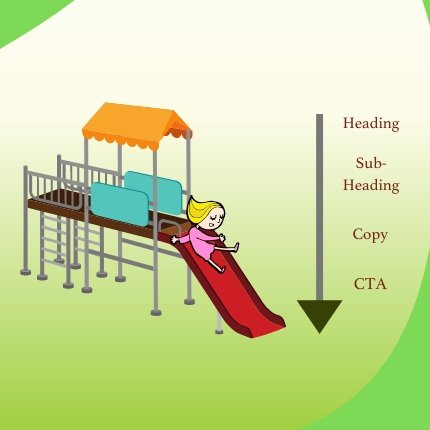
Would you want your prospect to jump off your copy and not read it through to the end? Obviously, you won’t.
That is why you ought to learn how to create a slippery slide.
Imagine yourself playing in the park on a slippery slide.
What happens when you start sliding on it?
Gravitational force starts to pull you down.
Once you start to slide, you don’t stop until you reach the other end of it.
And this is the type of experience you should give to your prospect.
You must guide your prospect to the end where your call-to-action is.
You wouldn’t want your prospect to jump off your copy and not complete the sale, would you?
But is it necessary to create a slippery slide? Yes, it is.
Let’s say a hundred people read your copy.
Do you believe every person who reads the copy makes the purchase?
The thing is, people are skeptical.
People only buy from those they trust.
Unless they are compelled to read your copy, they won’t read it. And as a result, they won’t convert.
So even if you don’t make as many sales as you thought you’d as an advertiser, chances are you’d make at least a few.
Now the question is:
How do you create a slippery slide?
This is where copywriting techniques come into the picture.
So read on.
4. Sell The Concept, Not The Product
You sell the sizzle and not the steak—the concept and not the product.
Joe Sugarman
Advertisers are often so focused on selling their products.
But think about it, why would anyone buy your product in the first place?
Do you have a concept?
Does your product solve any problem with a different approach?
If you are struggling to sell your products, then chances are you are only selling your product, not the why behind your product.
Sugarman says that if the product is unique, it becomes a concept on its own.
Does your copy tell the concept of your product?
Is the why behind your product clear to the prospect?
What makes your product different from others?
Answers to all these questions will lead you towards the conceptual side of your product.
5. Use The Power Of Storytelling
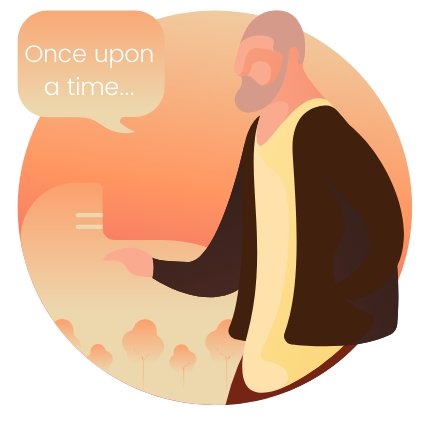
We all love stories.
Stories are what make our lives enjoyable.
We fantasize ourselves as the protagonist of the story of our lives.
No matter where we are, what we do, stories are a part of who we are.
Why do you think movies make billions of dollars? It’s because moviemakers sell stories.
Stories hook people in.
Let me tell you a tale of an ancient Arcadian prince…
You were expecting a great story, am I right?
So how do you use stories in copywriting?
Stories in the copy can be used to build an emotional bond with your prospect.
You can also use stories to hook people in.
People will start reading your story and wouldn’t even realize when they finished it. (They won’t if it isn’t compelling and enticing enough.)
The best stories engage the prospect and make them feel, see, and touch the elements of the story.
The prospect will skip the reading if the story is too obvious.
That’s why stories should be such that they mentally engage the reader.
For example, you can leave some clues here and there, let the reader do some work, and reach his own conclusion.
When the reader concludes by putting in mental effort, it gives him a sense of achievement.

And it becomes more likely that the reader or the prospect would love doing business with you. Because you made him feel something, you gave him a sense of winning a battle in his mind.
Do you see now how the scope of copywriting goes way beyond the sales copy?
6. Craft The Ideal Buying Environment

You might wonder what does this “environment” means in copywriting?
Sugarman talks about the buying environment.
Once you grab your prospect’s attention, your next goal should be to create a perfect buying environment.
What does this buying environment look like? It depends.
A perfect buying environment is what sets the prospect into buying mood.
Let’s say you want to sell health products. Would you sell them at an electronics store? Obviously not.
When it comes to an offline store, the prospect already enters a fixed environment. You can’t control the setting.
Also, the prospect can touch the product in a retail store before buying it.
When you write an ad copy, you only have words and graphics to persuade.
But the good thing is:
You have the power to build your own environment, which would set the buyer’s mood.
And while you craft your environment, you can choose what it contains and what it doesn’t contain.
Meaning? You have control.
This buying environment (often ignored) determines the experience of a buyer.
When a prospect lands on your copy, he starts to experience the environment that you have skillfully crafted.
The very first point of interaction of the prospect with your copy also plays a crucial role in determining the likelihood of whether the prospect will turn into a customer or not.
If the prospect isn’t in the mood to buy, likely, he won’t buy.
Therefore, set your environment right, and give a prospect the best experience to stand the chance of persuading him.
7. Connect With Emotions

Every word has an emotion attached to it.
Let me give you an example.
Say “Farmer.”
Could you imagine a hard-working and honest man working in his field?
Now, let’s say “Dentist.”
Could you imagine the dentist wearing his white uniform and treating a patient’s tooth with his scary tools?
Don’t worry if you didn’t imagine the same thing I said.
But you did imagine something, didn’t you?
This is the power of words. Words carry emotions with them.
It’s essential to connect with the prospect at an emotional level.
By using words strategically, a copywriter can connect with the emotions and imagination of the prospect and persuade him to do a specific activity.
Well, these words are often called Power Words.
When you connect emotionally with the prospect at a deeper level, you improve your chances of building trust.
Another reason for connecting with emotions is that humans are emotional beings.
Do you consider everything logically while buying something?
Well, I’m not saying that we don’t make logical decisions.
What I mean is that our decisions, most of the time, are based on our emotions while making a purchase.
Sugarman says that people buy with emotions and then justify them with logic.
Why do you think people love Apple products? Don’t cheaper Android phones do the same thing?
The answer to this is pretty simple:
We are emotional beings. And we buy “what we like” more than “what we need.”
Thus, connecting with the prospect’s emotions gives you the power to persuade effectively and resonate with him.
No matter what sales technique you are using, if you aren’t connecting with your reader, you leave something on the table.
You might also like:
- Why Emotion-Based Writing is Crucial to Your Business Goals
- How to Incorporate Psychology and Emotions into Your Copywriting
8. Be Honest And Transparent
Honesty and transparency play a key role in writing a persuasive ad copy.
Readers are astute these days. They know when you are bluffing.
Old tactics of scaring and lying don’t work anymore.
Readers have a mysterious power to spot a lie from miles away.
Trust is important. It’s common knowledge.
Would you buy from someone you don’t trust? No, you won’t.
Honesty builds credibility.
Transparency in what you are selling and why you are selling also helps improve credibility.
The reader doesn’t care about your copy. It is you who care about it.
People don’t want to make a fool of themselves. If they feel that something is fishy in your copy, then they jump off your copy regardless of how excellent your copy is.
9. Become An Authority
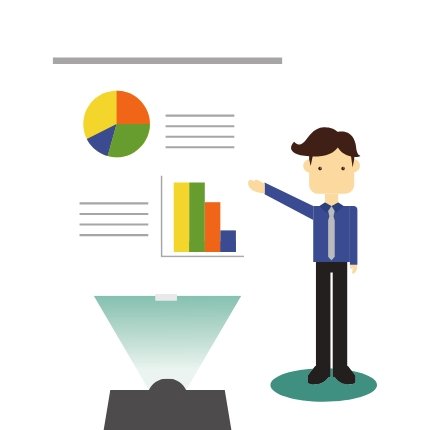
What does it mean to become an authority?
Do you even need to be one?
Let’s talk about it.
I’ll explain.
Let’s say you have to outsource an article about health.
Now suppose that there are two writers: one is a general writer, while the other is an experienced doctor who knows how to write.
Which one would you prefer?
Now you might say, “I don’t care, whoever will charge less, I would assign him the job.”
Imagine that somebody is suffering from a severe health issue. And he ends up reading that article you outsourced to a general writer.
What do you think would happen?
It can cause significant damage. Why? Because the general writer wasn’t an expert. He didn’t know much about health.
Would the advice of the general writer be helpful? Not that much.
That’s why experts are highly valued.
Experts have authority.
When you build authority, people are more likely to trust you.
And thus, experts get the superpower of convincing people to take action.
Become an expert on what you are selling.
Gather as much knowledge as you can.
Sometimes authority can be transferred.
Let me explain with another example:
Let’s say you have to advertise your football club in the newspaper. And your goal is to increase the number of joining applications.
Now, if a legendary footballer endorses your football club, then some of his authority will be transferred to you or your brand.
In simple words, when you have authority, your words have more power to convince your prospect to buy from you, even if your product isn’t that good.
People don’t have time to research everything. So they trust the experts. They think that if experts recommend something, it must be good.
Building authority often takes time. But it is possible.
One way to do this is to make complex things more straightforward.
If you can become the go-to person in your field, you can quickly build authority.
You might like:
4 Unexpected Methods for Becoming an Authority on Nearly Any Subject
10. The Power Of Social Proof

You can never underestimate the power of social proof.
Social proof guides the buying decision of all the people.
It’s simple:
If something becomes popular, then the perceived value of that thing also increases.
It means that if many people are buying it, it must be high-quality.
Sometimes, people don’t even read the entire copy if it doesn’t have some kind of social proof.
These days, reviews are a great source of social proof.
If your copy contains the positive reviews of your customers, then your copy is more likely to convince your prospect to buy from you.
There is a thin line between the reader turning into your prospect.
If you gain enough trust in your reader or prospect, you can urge him to cross that line.
And the social proof can play a significant role in that. It’s so powerful that it can turn an okay copy into an almost excellent copy.
The more social proof you have in your copy, the more potential your copy has to turn your reader into a buyer.
No person wants to be sold something. So buyers research before buying.
A single negative review can turn your prospect off.
So make sure that other people are saying good things about your product.
And if people are saying positive things and liking your product or offer, use that in your copy.
11. Know Your Prospect
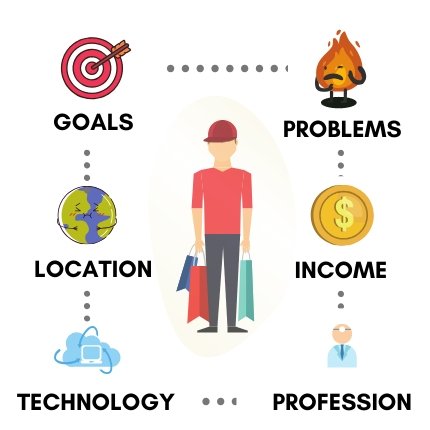
This is an obvious one.
But still, many copywriters skip this. They don’t put enough effort into learning about their consumers or prospects.
Answer me this:
Can you sell a diaper to an adult?
Even if you are a legendary copywriter, you will find it difficult.
That is why knowing about your ideal customers is essential.
You must clearly define who your target is and then strategize accordingly.
Is it easy to know your customer?
Yes, but not so easy.
You can start by figuring out where your ideal customer hangs out.
Once you do that, you can build a buyer persona.
A buyer persona represents the image and characteristics of the ideal customer.
All this process takes place before you sit to write your copy.
This way, you would never make the mistake of selling a diaper to an adult. Never mind.
12. Build A Relationship With The Prospect

Don’t just think of your reader as someone you can persuade and turn into a customer.
Readers are also people.
Doing business with a friend would always be the first option.
Try to provide value to your readers.
Let them use your product by offering a trial.
You can also provide your prospects the satisfaction conviction by giving them refunds if they don’t like your product.
Try to raise as many objections that can arise in your prospect’s mind, then resolve it in your copy.
Never confuse the reader. Remember that a confused prospect never buys.
This will allow you to make a frictionless sale.
Building a healthy relationship with the prospect means that you are doing genuine business with him by providing as much value as possible.
Sugarman says that people often felt guilty if they didn’t buy after reading his ad copy.
Your copy should have the same effect on your reader.
Instead of rushing and closing the deal, give room to a healthy relationship. This will help you in the long run.
13. Know Your Product

Can you sell something without even knowing about it?
No, you can’t unless you are super lucky.
Remember all the stuff about building trust, authority, and connection with the prospect?
If you don’t know about your product, you will never convince the prospect to buy it.
You having less knowledge about the product would show up in your copy.
This will lead the prospect with even lesser knowledge about your product and how it will benefit him.
So what do you think would happen?
Simply put, your prospect wouldn’t see any reason for buying your product.
Also, the more you explain your product, the more your product is perceived as a quality product that experts have built.
Knowing your products also helps clear any doubts that may cross the prospect’s mind.
You must know about your product’s strengths and weaknesses and technical stuff.
This is the ninja secret of writing a highly persuasive copy.
14. Be Simple, Be Specific
No person can be good at everything, so we trust the experts.
One job of the experts is to make complicated stuff simple so that even a kid would be able to understand.
The easier to read your copy is, the wider is its reach.
Again, being simple doesn’t mean that your copy should be all over the place.
Your copy must be designed according to your target audience.
According to Sugarman, if your product is simple, then explain as if it is complicated. And if your product is complicated to begin with, make it as simple as possible.
15. Build Curiosity

The human species is sometimes guided by curiosity.
People buy a product because they get curious about how it will change their lives.
They often wonder what fantastic experience awaits them if they buy a specific product.
A copywriter can plant the seeds of curiosity in his copy to ensure that his prospect reads the full copy.
Even scriptwriters use these curiosity elements in their scripts.
Think of the last movie you watched that kept you curious till the end. Did you watch it because you knew how it would end?
You watch movies because you don’t know the ending. Almost all the films have this curiosity element.
One strategy is to use open-ended loops by asking questions in your copy.
Although helpful, curiosity shouldn’t be overused because it can confuse the prospect.
16. Sell Transformation With Hope
Why do you think people buy fairness and anti-aging creams?
They buy them in the hope of becoming fair and slowing down the aging process.
Such products give them the promise of taking them from point A to point B in their lives.
Put simply: they sell transformation.
In the hope of transforming their lives into better ones, people buy them.
Combined with “curiosity,” “hope” can skyrocket the success of your sales copy.
17. It’s Easier To Sell A Cure Than It Is To Sell A Prevention
If I tell you that all you need is daily exercise and healthy food to stay fit. Would you believe this?
You might say, “Nah, it couldn’t be this simple.”
People don’t believe that simple things can solve more significant problems.
They are always looking for a magic pill that will cure their problem.
Therefore, if you are trying to sell prevention, few people would buy that.
On the contrary, if you are selling a cure, chances are more people would buy that depending on how severe the issue is.
18. The Incubation Process

Copywriting is a type of writing.
So the techniques you use while writing also apply to copywriting.
Sugarman says that you should give your subconscious mind enough time to generate ideas.
First, you should do the brainstorming part, then allow those ideas to settle in your subconscious for a while.
All this happens before you even start writing your copy.
In short:
Our subconscious is a source of creative energy.
So take a break, relax, and let the subconscious do its job.
You might also like: Steal like an artist summary and review
Want to Learn More About Marketing and Business?
=> Watch more than 14600+ courses on LinkedIn Learning taught by real professionals.
There is no better way than to learn from people doing business.
The good news is:
I have partnered with LinkedIn Learning.
That means: If you go through the link below, you will get a 1-month full access free trial, which will give you instant access to all the courses.
How to enroll? Simply click the link below and sign up.
In case you wish to continue after the 1-month trial ends, I recommend you go for the yearly plan as it will save you more money in the future.
Click here to claim your 1-Month LinkedIn Premium Free Trial
=>Try Blinkist non-fiction book summary app.
If courses are not your thingy, try the Blinkist book summary app.
Blinkist gives you more than 4500+ non-fiction summaries on many business books like this one.
Experts like Seth Godin are featured too on the podcasts (shortcasts) available on Blinkist.
It’s a fantastic app. I have been using it for 2 years now. I highly recommend this as it allows you to consume books in both text and audio format.
Click here to Sign Up and Start Blinkist 7-days risk-free trial
The Adweek Copywriting Handbook Infographic
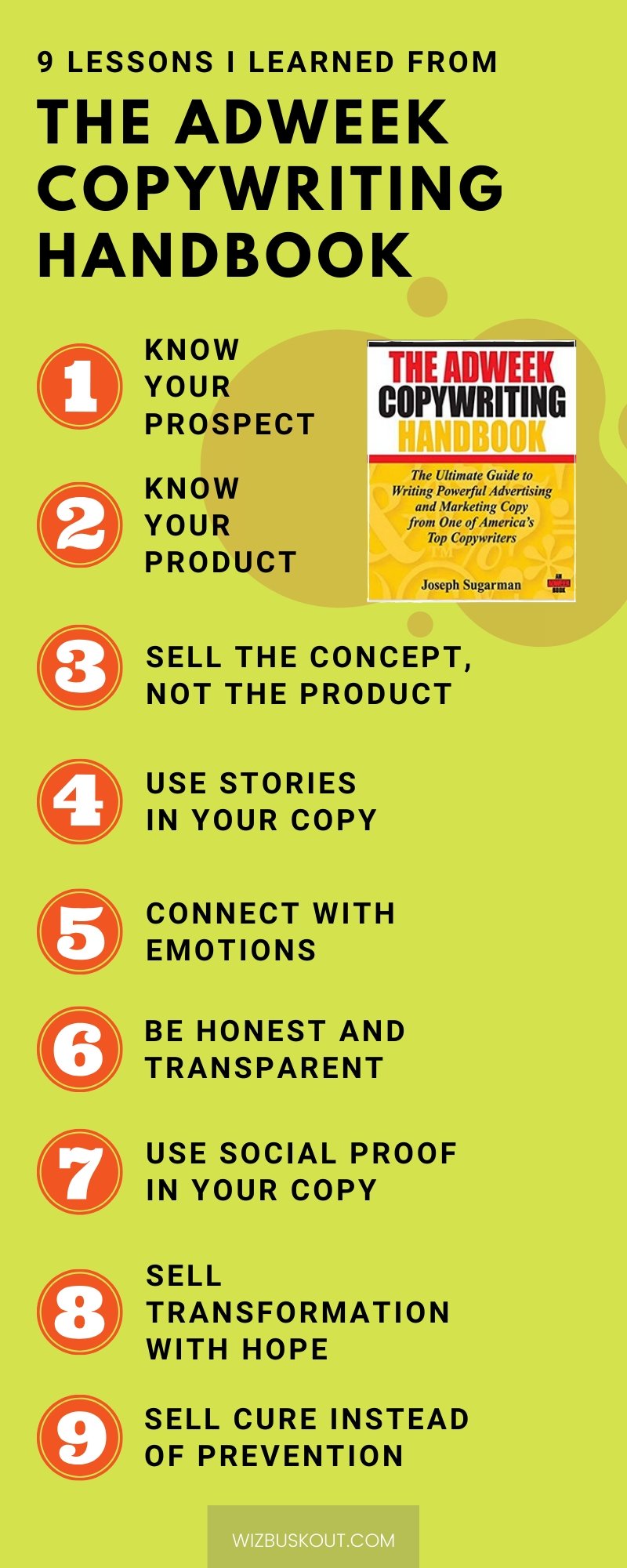
The Adweek Copywriting Handbook Review
[amazon box=”0470051248″ template=”horizontal”]
I was doing my research on copywriting…
That’s when I heard about this book on YouTube.
At first, I was skeptical of buying it considering the price of this book, which is relatively higher than other books.
But anyway, I bought it from Amazon.
I think I made the right decision.
Since then, this book has become my go-to source of Copywriting strategies.
This book is worth its price.
The Adweek Copywriting Handbook is divided into three main parts:
The first part shares the basic principles of copywriting.
The second part is the meat of this book.
In this part, Sugarman dives deep into the psychological triggers that help in persuading people to buy.
The third part consists of the ad examples to deepen the understanding.
This book helped me a lot in building confidence in my writing.
Who Should Read The Adweek Copywriting Handbook Summary?
Well, this is obvious:
If you want to master the art of persuasive writing, then you must give this book a shot.
You won’t believe me, but this book can change your life and put you miles ahead in your career.
All the wanna-be writers should read this at least once.
Why am I saying this?
Because if you fail to grab the attention of your reader and persuade him, you’ll fail eventually.
Now It’s Your Turn
I hope you enjoyed reading The Adweek Copywriting Handbook Summary.
Now you tell me:
Which strategy do you think is the most essential of all?
Have you ever written an Ad?
If you have experience and have more to add, tell me in the comments below.
